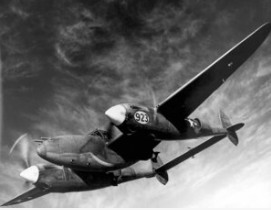FLASHBACK FRIDAY (1944) - P38 crash lands far afield in Ione; Pilot walks; Bill Rietmann cuts class; Juanita Rietmann gets fuel for iron
Editor’s Note - This story orginally published in 2020.
By Tom Peterson
In 1944, Werner and Juanita Rietmann got a knock on their door.
They did not get many visitors as they lived 4 miles west of Ione, Oregon.
That is some 90 miles southeast of The Dalles amidst rolling wheat fields.
It must have been strange.
Even more so when they saw an Army Air Force pilot before them asking to use the phone, said Bill Rietmann who was 16 years old at the time.
A Lockheed P-38 Lightning, a World War II–era American piston-engined fighter aircraft, had scraped down in a nearby stubble field.
The pilot had the unenviable position of borrowing the phone to call his superior and let him know the status of his training mission.
“I was about a junior in high school when it happened,” Rietmann said. “Four or five of us heard about it and cut school that morning to check it out. We were a bunch of kids. We had to see it. It landed belly down. He did not bend anything up. He probably cut the power off early enough and made a landing instead of a crash landing.”
It was not uncommon for military planes to be flying in the air space as the Boardman Air Force Range was within close proximity.
Even today, it is not unusual to be working in a field in eastern Oregon pulling rye or picking rock and get buzzed by a military jet. I experienced this while working in Gilliam County in the 1990s when a jet came up a draw next to a field so close I could see the pilot in the cockpit.
But back to 1946, Rietmann said he returned to school that morning for a bit of scolding.
Meanwhile, a ground crew was scuttled to retrieve the aircraft and take it to Portland.
They dismantled the plane, separating the wings from the fuselage, and loaded it onto trailers so it could be trucked out.
The plane was 37 feet long with a 52-foot wingspan. It had twin engines, a forked tail, could fly at 360 mph and carry up to 3,000 pounds in bombs. It was dubbed the “fork-tailed devil” by the Germans during the war as it had four .50-cal guns and a 20mm cannon in its nose. It weighed 17,500 pounds loaded.
Crews had to offload antifreeze and aviation fuel, Rietmann said. And those supplies were in short supply for farmers following World War II. Werner Rietmann and his brothers Otto, Dave and Bob were happy to take the fuel and antifreeze off their hands.
Once loaded, the crew had some other issues, Rietmann said.
“When they got a few miles from the sight, they had to go under an overpass. They were too high by a few inches. A nearby farmer came up with the idea to let the air out of the tires so they could go through, and they aired the tires back up on the other side.”
Legend in the Rietmann family is that Juanita Rietmann used aviation fuel in her gas-fired clothes iron, which was common prior to electricity being available.
Bill Rietmann, about “6 to 8 years ago” had one of the ground crew, out of curiosity, come back to Ione, and Rietmann showed him where the plane had landed.
“It really was a big deal at the time,” Rietmann said. “Most of the crashes were where people were killed and planes ruined, and this was a different situation.”
Read more from the Heppner Gazette.











Six local organizations joined together to donate $20,000 to the Columbia Gorge Food Bank to help address increased need in the community. Chenowith Water PUD, the City of The Dalles, Hood River Electric & Internet Co-op, Northern Wasco County People's Utility District, QLife, and Wasco Electric Cooperative presented the donation on Thursday, December 18.